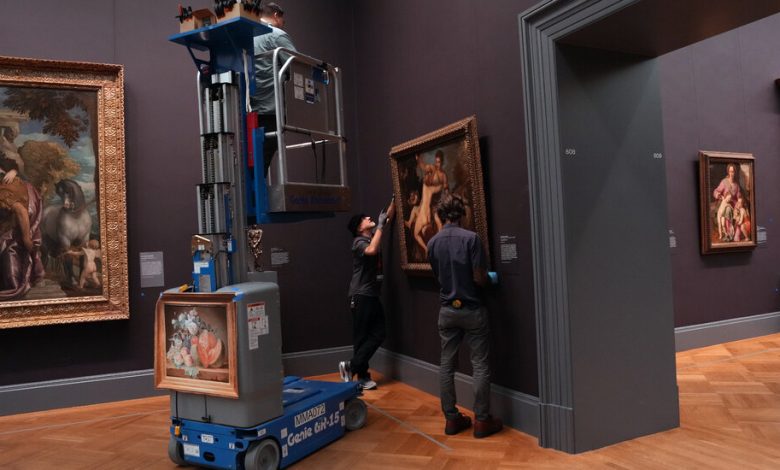679 Paintings. Sculptures. A Sword. The Met Moved Them All.

Good morning. It’s Thursday. We’ll get a look at some of the most popular galleries in the Metropolitan Museum of Art, which are about to reopen after a five-year renovation project. We’ll also find out what the chairman of the House Ethics Committee said about its investigation of Representative George Santos.

Credit…Michelle V. Agins/The New York Times
To renovate the galleries where it displays European paintings from the 1300s to the 1800s, the Metropolitan Museum of Art first had to clear 130,000 square feet of space — almost twice as much as in the entire White House.
That meant moving 679 priceless paintings and 112 other works of art — sculptures, furniture, musical instruments, even a sword.
Then a patchwork of drop cloths went down, and a forest of scaffolding went up. Doors were shifted a few feet to the left or the right, improving the sight lines in some of the galleries. About 1,400 skylights on the roof were replaced, many for the first time in 84 years. More than 7,000 glass panels in the ceilings of the 45 galleries were also replaced. Contractors did masonry repairs and repointing on interior and exterior walls. A new heating and air-conditioning system was installed, with more than 5,000 linear feet of ductwork.
All that took five years with a budget of $150 million, and then the art had to be moved back. Redoing the walls took 900 gallons of paint — two shades of blue, along with red, purple and gray for the trim. Rehanging the paintings took 10,000 feet of wire.
The ribbon to be cut at a ceremony tonight is 18 feet long.
And, starting Monday, museum goers can climb the marble steps just past the Great Hall and see the Rembrandts and Vermeers.
They are not where they were. Stephan Wolohojian, the curator in charge of the Met’s department of European paintings, said the renovation had let the Met “reconceptualize the presentation of the collection through a fresh lens.”
So now the paintings appear in chronological order. They used to be arranged by nationalities — the Italian paintings were grouped together, separate from the Dutch, the French, the German and the Spanish. “We’re not just throwing everything upside down and seeing where it lands,” Wolohojian said. “There is real order.”
That is not the only change. The galleries have been renumbered, so Gallery 602, for example, is to your left if you’re facing the west side of Gallery 601, not ahead and to the right. The Met says the new numbering complements the chronological layout.
The Met managed to do the renovation without closing all the galleries by scheduling the work in phases. Not until March of this year were all 45 galleries off limits to visitors at the same time.
As job sites go, said Michael Dominick, the Met’s senior associate building manager for infrastructure, this one was “essentially the size of a city block.” The panels for the skylights and the ceilings and the ductwork had to be hoisted in by a crane parked on the Central Park side of the Met.
The Met put a premium on efficiency and sustainability. Dominick said the three wings that house the 45 galleries were the biggest energy consumers at the museum. The improved efficiency of the new system is expected to save millions of dollars for the city, which pays the Met’s utility bills.
The new heating and cooling system will also save more than 1,700 metric tons of carbon dioxide emissions a year, the equivalent of taking 360 automobiles off the streets. The skylights alone will trim the Met’s overall carbon footprint by 7 percent, a significant reduction from a change that most visitors will never notice.
The skylight project was high on a list of deferred maintenance and repair work that the Met compiled a decade ago. Dominick said condensation on the old skylights could drip on the ceiling panels — and into the galleries. To prevent that, the Met turned the thermostats up to a blazing 120 degrees in the attic, the giant and mostly open space between the skylights and the galleries. Such temperature settings will no longer be necessary.
As for where the paintings went while the renovations were going on, the Met played a game of musical masterpieces, shuffling many to temporary locations in other parts of the museum.
But huge paintings by the 17th-century Venetian Giovanni Battista Tiepolo didn’t go anywhere. They couldn’t — they are too big. One, “Triumph of Marius,” measures 18 feet by 10 feet and is the largest item in the European painting galleries. The Tiepolos never came off the walls — the Met painted around them, very carefully.
Weather
Enjoy some sunshine and high temperatures in the low 60s during the day. Temperatures will dip in the evening to the mid-40s.
ALTERNATE-SIDE PARKING
In effect until Nov. 23 (Thanksgiving Day).
The latest New York news
Law and order
-
Gerrymandering: Democrats try to persuade the Court of Appeals, New York’s highest court, to give their party a chance to redraw the state’s congressional map.
-
Trump trial: Lawyers for Donald Trump called on Wednesday for a mistrial in the civil fraud case against him in New York, arguing that the judge and his law clerk were politically biased against him.
Arts and culture
-
Million-dollar stamp: Somebody accidentally created the most famous postage stamp in American history, which recently sold for more than $2 million.
-
A new office: Steve Carell, the screen actor best known for his breakout role as a blundering boss in the NBC comedy “The Office,” will make his Broadway debut in a revival of the Chekhov classic “Uncle Vanya.”
More local news
-
Busted bikes: Citi Bike riders in New York City are getting bad service, and the problem is worse in low-income neighborhoods, the city comptroller said in a report released on Wednesday.
-
Campus protest: Hundreds of Columbia students rallied after the university suspended two pro-Palestinian groups from holding campus events, and faculty members said they would walk out in protest.
House panel won’t push to expel Santos
The House Ethics Committee will not push to expel Representative George Santos.
Representative Michael Guest, the chairman of the ethics panel, said it would not make a recommendation on Santos’s fate. Attempting to do so would have lasted “well into next year,” he said.
Beyond that, Guest, a Republican from Mississippi, said he would not characterize the committee’s findings.
He said the committee’s report, which could be released as early as today, would provide House members the information they need to decide on whether a penalty is appropriate for Santos. The panel has been investigating a range of allegations of criminal and ethical violations, including accusations that Santos fraudulently obtained unemployment benefits, failed to properly file financial disclosures, sexually harassed an employee and violated conflict of interest laws.
Santos has already survived two expulsion attempts in the House, the second just two weeks ago, when a group of New York Republicans pushed for a floor vote. That measure was soundly defeated, with numerous Democrats voting not to expel Santos on the grounds that removing him while an ethics investigation and a criminal proceeding were underway would set a dangerous precedent.
On Wednesday Representative Nick LaLota, a Republican from New York, said that he would reintroduce a motion to expel Santos once the ethics committee’s report had been made public and his colleagues had been given a chance to absorb it. He said he expected the revived resolution to have a better chance of passing.
Santos has resisted calls for his resignation and has pleaded not guilty to charges stemming from a 23-count federal indictment that includes allegations of money laundering, wire fraud and aggravated identity theft.
METROPOLITAN diary
Lunch money
Dear Diary:
It was summer 1980, and I was a 19-year-old college student working as a part-time teller for what was then Greater New York Savings Bank at a branch in Flatbush.
I worked around 20 hours a week, earned $3.35 an hour and, as I recall, took home around $45 in a typical week. Because I lived at home, that was good money.
My hours included working on Saturdays from 9 a.m. to 1 p.m. One Saturday, I was told another teller was needed at a different branch. To make the assignment more palatable, my manager gave me $5 for lunch and $20 for a taxi.
Never one to miss an opportunity, I went to the deli next door and bought a bagel with cream cheese for $1 and a soda for 50 cents. Then I got on the subway for 60 cents.
Needless to say, after that I always volunteered to travel to other branches when a fill-in was needed. The other tellers just couldn’t understand it.
— Rudyard F. Whyte
Illustrated by Agnes Lee. Send submissions here and read more Metropolitan Diary here.
Glad we could get together here. See you tomorrow. — J.B.
P.S. Here’s today’s Mini Crossword and Spelling Bee. You can find all our puzzles here.
Kellina Moore and Ed Shanahan contributed to New York Today. You can reach the team at [email protected].
.





